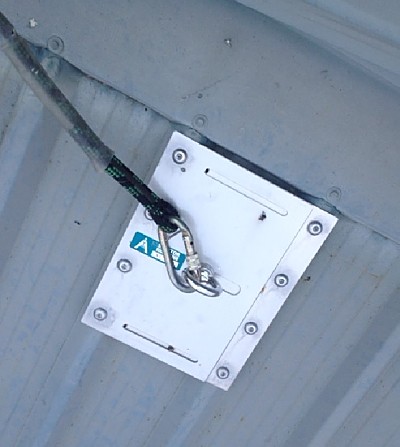General Surface Anchor Info
Before selecting any surface mounted anchor as a safety device, read this page.
Surface Anchor Testing on Roofing Material:
There are many types of height safety surface mounted anchors designed for fall-arrest and lifelines that are in use on buildings today. These anchors are attached to roofing material using rivets, screws or bolts. These anchors are manufactured using a 4mm Stainless Steel mounting plate with no form of backing plate. The tests we had carried out using a riveted type system alerted us to the fact that this type of system is not recommended for use as a fall-arrest anchorage device.
Corrosion of Metal Roofing:
Metal roof and wall cladding is widely used in New Zealand and Australia for all types of buildings while the rest of the world tends to restrict the use of metal cladding to farm, industrial and commercial buildings. In New Zealand 70-80% of housing is clad with metal roofs of long run or metal tiles, made, supplied and often installed by members of NZMRM. This is one of the reasons why the NZMRM executive agreed to invest a significant amount of money, time (4-6 years) and effort to investigate the specific causes for the deterioration that can occur when metal claddings are used in corrosive areas (predominantly by the sea) and determine how this can be avoided.
Read all about the The NZMRM Corrosion Project (view by clicking here)

Point Loading on Cladding
Point Loading: A load used in a testing regime as a measure of the ability of roof or wall cladding to support a person with a bag of tools, at mid span. A point load is often the most severe of the imposed loads which is calculated at 112 kgs = 1.1 kN. As required by AS/NZS 1170.1 the point load is taken as 1.1 kN over an area of 100mm diameter in the case of a superimposed load, such as anchor points, the area of contact if the load is not directly attached to the structure. A point load on a roof is always positive or downward.
Roof and wall cladding is required to comply with the requirements of the NZBC clauses B1, B2, E2, E3, and also with AS/NZS 1170.
Our Recommendation:
We recommend the use of our Structural Height Safety Anchors which have a life of 20 years, whereas the surface mounted anchor has a life of 1 to 3 years on new roofing.
Total Restraint:
Under Appendix F of the AS/NZS 1891.4:2009 Standard, total restraint is defined as the control on a persons movement by means of a connection to an anchorage in such a way that it will physically prevent the person from reaching any position at which there is risk of a fall, either
- over an edge
- through a surface
- due to a failed moveable platform.
Reduced Life on Roofing Iron:
All types of surface mounted anchors are attached directly to the roofing, either by rivets or some form of stitching screws. Because of this method of attachment, the life of the roofing that the anchor is attached to is reduced to only a few years.
Surface Anchor Life:
The life of a surface mounted anchor is around 7 years on it`s own. The life of new roofing at the attachment point is around 1 to 2 years.
Stress, Cracks & Leaks
Stress that is caused by any type of surface mounted anchor plays a large role in reducing the life of the roofing iron and may cause leaks or other damage.
Increased Stress:
When a surface mounted anchor is attached to the roofing it restricts the natural curve of the roofing iron between the purlins, and places a greater stress factor on the anchor fixings. Within a short amount of time the roofing iron can crack at the fixings, which makes the surface anchor unsafe and the sheet of roofing iron the surface anchor is attached to has to be replaced.
Anchor Failure:
All Corrugate and Trapezoidal roofing is designed to curve or sag downward between the screw of nail fixings at the purlins. This is part of the design of all metal longrun roofing. When a topfix / surface mounted anchor is attached to the roofing, it restricts the sag or curving of the roofing and creates stress on the metal roofing around the anchor attachment fixings. This will cause the anchor to fail in a very short time.
Topfix or surface mounted anchor failure can be caused by these events
- Exapansion and contraction due to shifting day/night temperatures
- Rain and Snow loading
- Wind force
- Foot traffic
NB: Anchor failure can cause serious injury or even death, leading to prosecution and fines.
Fixings:
The manufacturers of roof screws have only tested fixing screws into 1.2mm steel. Screws that are used to attach the anchor to the roofing iron are not rated.
Reducing Stress
We at Collins Corporation Ltd. have taken steps to ensure that our surface anchors reduce as much stress as possible on the roof iron at the attachment point, thus adding a slightly longer life to the roofing.
Working in Elastic:
The CPENG`s Structural guideline is “Always work in elastic and not in plastic”.
When working in Elastic you are creating less stress. When working in Plastic you are creating more stress. (see Hook’s Law)
Installation:
The installation should only to be carried out by a competent person as set out in the AS/NZS 1891.4:2009 Standards. Collins Corporation Ltd. provide a warranty on product performance of the anchor but not the structure or the roof sheeting. It is the responsibility of the installer, building designer or building owner to ensure that the structure to which the anchor is attached will support a load as set out in Appendix F of the AS/NZS 1891.4:2009 Standard. If there is any doubt about the structures adequacy, a structural engineer should be consulted.
For more information contact:
Nick Collins
Mobile: 021 448 004
Email: nick.roofanchors@gmail.com